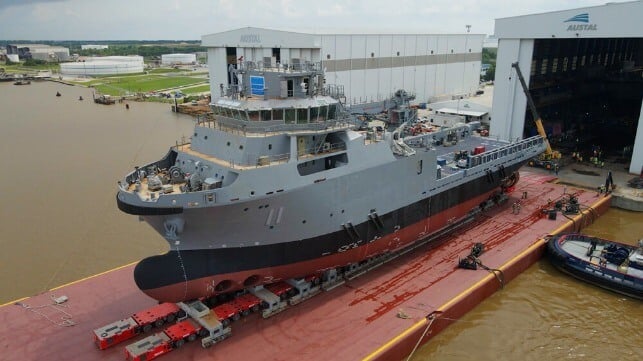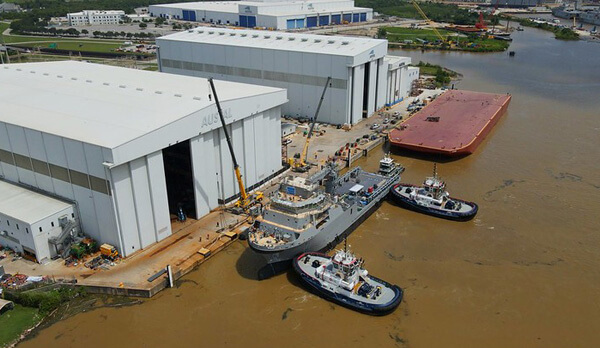Austal USA Launches First Steel Ship Marking Expansion from Aluminum

Austal USA marked a key milestone in its shipbuilding operation recently with the rollout and launch of its first steel ship, the future USNS Billy Frank Jr. (T-ATS 11). The company is best known for its large aluminum vessels and the Independence-class Littoral Combat Ship, started the transition into steel five years ago responding to the U.S. Navy’s concerns over the durability of lighter-weight aluminum vessels.
USNS Billy Frank Jr. is seen as a kickstart for the shipyard to develop its skills in steel construction and its newly developed automated steel panel line. The Navy in 2019 began planning its return to all steel construction and the Department of Defense supported Austal in its efforts to develop the capabilities. This included a $50 million matching grant toward the construction of the steel line and the development of additional capacity for steel naval vessel construction at its Mobile shipyard.
Work began in July 2022 for the first-ever steel cutting at the Mobile facility and kicking off the Navy Towing, Salvage, and Rescue Ship program. Austal USA won a contract for three of the hulls as its first steel job. The rollout of the first vessel took place on June 14 in Mobile.
“It was amazing to see the flawless rollout of our first steel ship,” said Harley Combs, vice president of surface ship programs. “The completion of this milestone is the result of the hard work and dedication of our talented workforce.”
At 3,100 metric tons, T-ATS 11 is also the heaviest ship Austal USA has launched to date. The launch was executed using the process used to launch most of the 32 Navy ships the company has built and delivered over the last 15 years. The multi-step method involves rolling the ship onto a moored deck barge and then transferring the ship from the barge to a floating dry dock. The dry dock is submerged enabling the ship to float for the first time and then removed from the dry dock and moored pier side.

Future USNS Billy Frank Jr. afloat and positioned to the fitting out berth (Austal USA)
The ship was over 85 percent complete at the time of launch. Austal reports the future USNS Billy Frank Jr. will now prepare for her next major milestone, the engine light off, as she gets ready for sea trials and delivery.
T-ATS will provide ocean-going towing, salvage, and rescue capabilities to support fleet operations. It will have a multi-mission common hull platform capable of towing U.S. Navy ships and will have 6,000 square feet of deck space for embarked systems. The large, unobstructed deck allows for the embarkation of a variety of stand-alone and interchangeable systems.
The class was designed to combine the capabilities of the retiring Rescue and Salvage Ship (T-ARS 50) and Fleet Ocean Tug (T-ATF 166) platforms. It will be able to support current missions including towing, salvage, rescue, oil spill response, humanitarian assistance, and wide-area search and surveillance. The platform also enables future rapid capability initiatives such as supporting modular payloads with hotel services and appropriate interfaces.
While it is the first steel construction for Austal, the prize was a $3 billion contract for seven ocean surveillance ships for the U.S. Navy awarded in 2023. In addition, after committing to its steel capability, Austal also received a contract for the Navy’s Auxiliary Floating Drydock Medium (AFDM) and in a contested decision, Austal beat out Eastern Shipbuilding to secure follow-on hulls for the U.S. Coast Guard Offshore Patrol Cutter (OPC) program.
The addition of the steel capability is critical for the yard as it works to complete the delivery of its final Independence-class Littoral Combat Ship. The future USS Pierre (LCS-38) was launched in August 2024 as the final ship of the series for Austal. The company highlights that it is closing more than a decade of work as this series winds down. The yard was established in 1999 focusing on aluminum and the demand for more capacity to meet the needs of the U.S. Navy.
